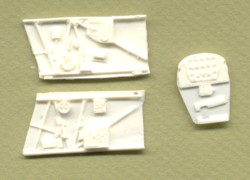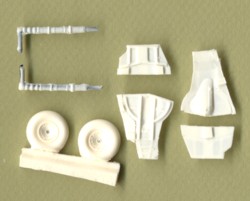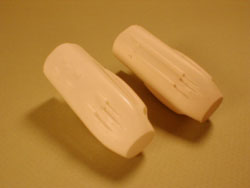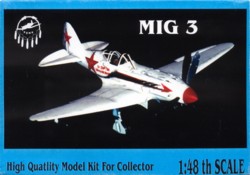History At the end of 1940, the Mig-1 was modified in order to increase its range, reduce vulnerability and improve handling characteristics at high angles of incidence. The revised design became the Mig-3 and won the Stalin Prize for its designer. It retained the low-wing configuration and general outline of its predecessor, with main wheels retracting inward into the wings with a fully retractable tailwheel, but differed in a number of respects. A sliding, glazed canopy replaced the open cockpit of the Mig-1. Behind the canopy, the upper fuselage had glazed panels in order to improve vision to the rear. The dihedral on the outer wing panels was increased. An additional 52-gallon fuel tank was located beneath the pilot's seat. The ventral radiator was increased in size in size and located further forward. The Mig-3 was built in large numbers, output (including Mig-1's) totaling 2,100, and it formed the backbone of the Russian high-altitude fighter force. Early wartime experience showed that it was outstanding at altitudes above 16,400 feet (5,000 meters), as at this height it achieved a higher performance and showed better tactical characteristics than any fighters the Luftwaffe had available before 1942. Below this altitude, however, speed and climb were inferior. As a result the Mig-3 had little value as a front line fighter. From the earliest days of the war it was evident the one heavy and two light machine guns were inadequate for the Mig-3. Two additional 12.7mm machine guns were installed under the wings. Increased armor protection was also introduced. These modifications were installed in the aircraft at their operational airfields. Production of the Mig-3 only lasted until the autumn of 1941. Production of the Mig-3 was halted in order to produce Ilushin Il-2 Stormoviks, which were desperately needed.  The Kit The Kit
I am always impressed with Pend Oreille Model Kits (POMK). In my experience they are cast in high quality resin. The resin pieces themselves are well cast with finely scribed panel lines. POMK is one of the companies that I measure all other resin manufacturers against. One might ask why I bother to review a resin 1/48 Mig-3 when a plastic injected kit of the same subject is available. I would have two answers. The first is after building the ICM kit I think the POMK kit might be simpler to build. The second answer I would offer is the POMK offers an early and late version of the Mig-3. The ICM kit only offers a late version.  The resin POMK kit consists of 33 resin pieces (opposed to ICM's 119 parts). They are all very crisp and clean with a nice smooth finish. The fuselage and cowling are as thin as most Japanese plastic kits. The one-piece wing (compared to the 13-piece ICM wing) has trailing edges that look a trifle thick. The separate control surfaces are great replicas of fabric covered surfaces. No fabric texture and nice, subtle rib detail. I did not find any pinholes in the major components of this kit. Careful trimming will be required to fit the nose to the assembled fuselage. That will probably be the most challenging area to this kit. The resin POMK kit consists of 33 resin pieces (opposed to ICM's 119 parts). They are all very crisp and clean with a nice smooth finish. The fuselage and cowling are as thin as most Japanese plastic kits. The one-piece wing (compared to the 13-piece ICM wing) has trailing edges that look a trifle thick. The separate control surfaces are great replicas of fabric covered surfaces. No fabric texture and nice, subtle rib detail. I did not find any pinholes in the major components of this kit. Careful trimming will be required to fit the nose to the assembled fuselage. That will probably be the most challenging area to this kit. The detail parts are also finely cast. The interior detail parts consist of foot pedals, a nicely done seat and joystick, as well as detailed structure and instruments. Once again the detail rivals the ICM kit. There will be more work involved removing the smaller pieces from the casting plugs. This really isn't any harder than removing some serious flash from a plastic kit. One interesting feature in this POMK kit is the landing struts are cast with wire inside. The modeler won't have to worry about the resin landing gear sagging under the model's weight in a year's time.  POMK supplies the modeler with two vacuform canopies. I always like it when a manufacturer does this. As I have mentioned before, I always botch the first one. My copies are great. There are no annoying "pips" in evidence. They are completely usable. POMK supplies the modeler with two vacuform canopies. I always like it when a manufacturer does this. As I have mentioned before, I always botch the first one. My copies are great. There are no annoying "pips" in evidence. They are completely usable. There is no decal sheet supplied. Instead a copy of an Aero Master sheet is included. The instructions include the part numbers of the Mig-3 Aero Master decal sheets. The same sheet is included in the early and late Mig-3 kits so it is not clear which markings are for early or late Mig-3's. I guess you will have to check with Aero Master. The instruction sheet is a spartan affair, but it includes enough information to build the model. The modeler will need to consult his references as to the interior colors of the model. Conclusion This is a great resin kit. From what I've seen of Mig-3 kits this may be the easiest one to assemble. The ICM kit does have some advantages. The plastic kit comes with removable panels to display the engine, separate leading edge slats and plenty of decals. However I think the POMK kit has advantages too with its one-piece wing and the option for an early or late model. I need to stress that the early and late models are separate kits. Parts to make either do not come in one box. From what I've seen the PART photo etch set will work for most of the POMK kit too. The exception being the flaps. They would be difficult to carve out of the one-piece resin wing. POMK also offers a one-piece replacement wing for the ICM kit as well as bulged tires. If you have been frustrated by the ICM kit this would be a good alternative. I would also recommend it as a first resin kit. POMK resin kits hold a very high standard that I wish other manufacturers would hold. As a final note I want to add the POMK has great customer service. My copy of the early Mig-3 arrived without a nose. A replacement arrived promptly after I wrote a letter to them explaining my problem. They were not aware I would be writing this review. Kudos to them! I would like to offer special thanks to Roll Models for obtaining my review copy. | 


 



  
    |
 The Kit
The Kit The resin POMK kit consists of 33 resin pieces (opposed to ICM's 119 parts). They are all very crisp and clean with a nice smooth finish. The fuselage and cowling are as thin as most Japanese plastic kits. The one-piece wing (compared to the 13-piece ICM wing) has trailing edges that look a trifle thick. The separate control surfaces are great replicas of fabric covered surfaces. No fabric texture and nice, subtle rib detail. I did not find any pinholes in the major components of this kit. Careful trimming will be required to fit the nose to the assembled fuselage. That will probably be the most challenging area to this kit.
The resin POMK kit consists of 33 resin pieces (opposed to ICM's 119 parts). They are all very crisp and clean with a nice smooth finish. The fuselage and cowling are as thin as most Japanese plastic kits. The one-piece wing (compared to the 13-piece ICM wing) has trailing edges that look a trifle thick. The separate control surfaces are great replicas of fabric covered surfaces. No fabric texture and nice, subtle rib detail. I did not find any pinholes in the major components of this kit. Careful trimming will be required to fit the nose to the assembled fuselage. That will probably be the most challenging area to this kit. POMK supplies the modeler with two vacuform canopies. I always like it when a manufacturer does this. As I have mentioned before, I always botch the first one. My copies are great. There are no annoying "pips" in evidence. They are completely usable.
POMK supplies the modeler with two vacuform canopies. I always like it when a manufacturer does this. As I have mentioned before, I always botch the first one. My copies are great. There are no annoying "pips" in evidence. They are completely usable.







